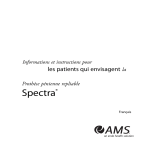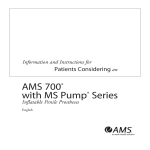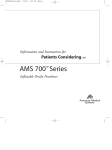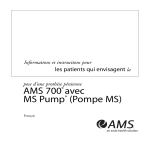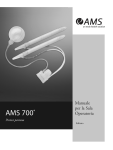Download AMS Spectra - AMS Labeling Reference Library
Transcript
Information and Instructions for Patients Considering an Spectra® Concealable Penile Prosthesis English American Medical Systems, Inc. U.S. Headquarters 10700 Bren Road West Minnetonka, MN 55343 U.S.A. U.S. Toll Free: 800 328 3881 Tel: +1 952 930 6000 Fax: +1 952 930 6157 American Medical Systems Europe B.V. Haarlerbergweg 23 G 1101 CH Amsterdam Zuid-Oost The Netherlands Tel: +31 20 593 8800 Fax: +31 20 593 8830 American Medical Systems Australia Pty. Unit 31, Building F 16 Mars Road Lane Cove NSW 2066 Australia Tel: + 61 2 9425 6800 Fax: + 61 2 9427 6296 American Medical Systems France S.A.S. 19 avenue de Norvège Les Fjords - Bâtiment Nobel 91953 Courtaboeuf Cedex France Tel: + 33 (0) 1 69 59 97 00 Fax: + 33 (0) 1 69 59 97 29 American Medical Systems Benelux BVBA Haarlerbergweg 23 G 1101 CH Amsterdam Zuid-Oost The Netherlands Tel: +31 20 593 8800 Fax: +31 20 593 8830 American Medical Systems Ibérica S.L. C/Joaquin Turina 2 Planta primera - Oficina 6 28224 Pozuelo de Alarcón (Madrid) España Tel: + 34 91 799 49 70 Fax: + 34 91 715 75 26 American Medical Systems do Brasil Produtos Urológicos e Ginecológicos Ltda. Av. Ibirapuera, 2907 conj 1212 São Paulo-SP CEP 04029-200 Brasil Tel: + 55 11 5091 9753 Fax: + 55 11 5053 9709 American Medical Systems Canada Inc. P.O. Box 461 Guelph, Ontario N1H 6K9 Canada Tel: +1 519 826 5333 Fax: +1 519 821 1356 American Medical Systems Deutschland GmbH Voßstr. 20 D-10117 Berlin Deutschland Tel: + 49 (0) 30 20 64390 Fax: + 49 (0) 30 20 643999 AMS Sverige AB Frösundaviks allé 15 169 70 SOLNA Sverige Tel: + 46 (0)8 - 624 74 90 Fax: 020 - 160 58 04 Kundtjänst: 020 - 160 58 03 American Medical Systems U.K. Ltd. Capital Court Capital Interchange Way Brentford TW8 0EX United Kingdom Tel: + 44 (0) 20 8996 3100 Fax: + 44 (0) 20 8995 3720 Table of contents Topic Page number 1. About the Spectra Concealable Penile Prosthesis 1 2. What to Expect 3 3. About the Surgery 4 4. Advantages of the Spectra Concealable Penile Prosthesis 4.1 Return of erectile function 4.2 All components are internal 4.3 Easy to operate 4.4 Outpatient surgery possible 6 6 6 6 6 5. Risks associated with the implantation of a penile prosthesis 5.1 Risks associated with the surgery 5.2 Loss of latent erectile ability 5.3 Shortening or curvature 5.4 Silicone 5.5 Surgical technique 6 6 6 7 7 8 6. Problems that may develop after surgery 6.1 Infection 6.2 Pain 6.3 Erosion 6.4 Migration or extrusion 6.5 Mechanical problems 6.6 Other complications 8 8 8 9 9 9 10 7. Airport Security Information 10 8. Magnetic Resonance Imaging (MRI) Information 11 9. Review of treatment options for physical causes of impotence 9.1 Medication 9.2 Vacuum erection devices 9.3 Injections 9.4 Vascular surgery 9.5 Surgical implants 11 11 11 12 12 12 10. Troubleshooting 14 11. Final Statement 15 Introduction By now, you have probably learned about the various causes of impotence (also known as erectile dysfunction, or the inability to have an erection) and the possible treatment alternatives from your urologist. After testing to determine the cause of your erectile dysfunction and a discussion of the possible treatment alternatives, you are seriously considering being implanted with a Spectra® Concealable Penile Prosthesis from American Medical Systems, Inc. (AMS). There are many things you should understand about the Spectra penile prosthesis and the implant surgery before making your final decision. The information in this brochure, along with the information you receive from your urologist, should help you evaluate the risks and benefits of the Spectra. In addition, this brochure will outline how the device works, problems that may happen after the device is implanted, and when to contact your urologist. If you have any questions about the Spectra Concealable Penile Prosthesis, the implant surgery, or any other issues regarding your impotence treatment, please discuss them with your urologist. 1 About the Spectra® Concealable Penile Prosthesis The Spectra Concealable Penile Prosthesis is used to treat impotence (erectile dysfunction) that is constant and that has a physical cause (such as a result of diabetes). The Spectra should be considered only after other less invasive treatments have been discussed with your urologist. These treatments could include vacuum devices, injection therapy, hormonal therapy, or psychological counseling. Your urologist can provide you with more information about the advantages and risks associated with these treatments. This device consists of a pair of cylinders which are surgically implanted in the penis to provide rigidity. Each device consists of two cylinders, and in some cases, may include rear tip extenders for additional length (Figure 1). All components are made of implantable, biocompatible materials. Figure 1: Spectra Cylinder and Rear Tip Extender The cylinder consists of an articulating section of alternating polyethelene and titanium segments. A cable extends through the center of the articulating segments. The ends of the cable are each connected to a stainless steel spring that is encased in a titanium housing. The entire outer surface of the cylinder is made of silicone (a rubber type material). -1- The articulating segments, held together by the cable and spring assemblies, allow you to position the device for concealment or for intercourse (Figure 2). Articulating segments Figure 2: Spectra with outer silicone sheath removed The Spectra Concealable Penile Prosthesis is a device that is easy to manipulate. You simply bend it downward for concealment (Figure 3a) or upward for an erection (Figure 3b). Figure 3a: Concealed Position Figure 3b: Erect Position -2- 2 What to Expect Before your implant surgery, you should talk to your urologist about what to expect after the Spectra penile prosthesis is implanted. There may be physical (the way your penis looks), psychological (how you feel about the prosthesis), or functional (how the prosthesis works) expectations that need to be discussed. The erection that you have with Spectra may be different from your original, natural erection. These differences could include a shorter or curved penis, less firmness, and less width. The surgery may have caused scarring or your penis may not become as soft as it did naturally, making it difficult to conceal or hide the device when wearing certain clothing. Examples to be aware of are: • The prosthesis will not provide rigidity to the glans (the tip of your penis), so this part of your penis may not be firm. • The implant will not enhance or restore libido, penile sensation, or the ability to have an orgasm and ejaculate. • Implantation of the Spectra is likely to damage or destroy your natural ability to have an erection. As with any penile rigidity implant, this device is subject to wear due to normal daily activities and eventual failure is expected over time. It is not possible to know how long a device will function in your body. You should be aware that the implant is not considered a lifetime prosthesis. Currently, there is no data on revision rate for this device. However, in a study of the Dura II penile prosthesis (similar to this device) the revision rate was reported as 5.1% after two years post-implant for 196 patients. There were no mechanical failures reported.1 The articulating segments of Spectra may produce vibration and/or sound during movement. You may be able to feel it or hear it, but this is normal. 1 WS Kearse, Jr., AL Sago, SJ Peretsman, JO Bolton, RG Holcomb, PK Reddy, PH Bernhard, SM Eppel, JH Lewis,M Gladshteyn, AA Melman. “Report of a Multicenter Clinical Evaluation of the Dura-II Penile Prosthesis.” J. Urol. 155: 1613-1616, 1996. -3- Discuss all of these possibilities with your urologist before making an appointment to be implanted with the Spectra Concealable Penile Prosthesis. You may also want to include your partner in these discussions. 3 About the Surgery Your urologist should be able to give you a thorough explanation of what will happen during the surgery and the rest of your hospital stay. In general, the procedure begins with some preoperative tests, which may include blood tests, a urine analysis, and delivery of antibiotics. Depending on your physical condition and your urologist’s preference, you will either be given a local anesthetic (it numbs only the area where the surgery occurs) or a general anesthesia (which puts you to sleep for the surgery). If you are to be given a general anesthetic, you will be asked to abstain from eating or drinking for 12 hours before surgery. The device is implanted completely within your body, usually through one of the following two kinds of incisions. Your urologist will choose the right one for you: • penoscrotal (between your penis and scrotum) • subcoronal (underside of penis, at base of glans) To implant the cylinders, your urologist will first dilate (widen) the corpora cavernosa (the two channels in the shaft of your penis which fill with blood when you get a natural erection). Then your urologist will measure this area to choose which cylinders will best fit your anatomy. He will select the cylinder size that is closest to the measurement. If needed, he will add rear tip extenders to the cylinders to adjust the size for the best possible fit. After surgery is completed, your urologist may tape your penis against your abdomen. Your urologist may insert a catheter (a hollow tube) into your penis to drain your bladder. The catheter will be removed before you leave the hospital. -4- Caution: Immediately contact your urologist if you notice any redness, swelling, and/or heat around the incision area, or drainage from the incision after the surgery. These symptoms may indicate an infection. Many urologists recommend that you wait four to six weeks before having intercourse. It is important that you follow your urologist’s instructions about when you can begin having intercourse. Your incision site will need to heal before you attempt intercourse. If you attempt intercourse before the incision has healed completely, you risk the possibility of infection and/or pain and breaking open the incision. Prior to leaving the hospital, discuss with your urologist proper care of the device and the surgical site, and guidance for urination during the healing period. This discussion may include: • Minimizing catheter use • Administering routine wound care • Resuming sexual activity 4-6 weeks after surgery • Receiving education on your new penile prosthesis You may experience pain at the operative site initially after surgery and when you first use your prosthesis. In most cases the pain goes away within a few weeks of surgery; however, cases of chronic (continuing) pain have been reported. You will most likely have an appointment with your urologist during this period to be sure you are healing properly. Be sure to discuss these possibilities with your urologist. You will also have several follow-up visits with your urologist after the surgery. During and after this recovery time, take care to avoid trauma to the pelvic area. Always keep in mind that you have a surgically implanted device and choose your activities wisely. Examples which may cause pelvic area trauma include seat belt jolts from a car accident, being tackled in contact sports, or slipping and falling on ice. Trauma such as these may damage the prosthesis or surrounding tissues. Caution: Take precautions to avoid trauma to the pelvic area. -5- 4 Advantages of the Spectra Concealable Penile Prosthesis 4.1 Return of erectile function The biggest benefit of the Spectra penile prosthesis is the ability for an appropriately selected patient to have an erection suitable for sexual intercourse. The Spectra allows you to have an erection which can be easily controlled by bending the penis into either the erect or concealed position. 4.2 All components are internal The Spectra penile prosthesis is completely implanted within your body. There is no need to use an external device when you want to have an erection. 4.3 Easy to operate To use the Spectra penile prosthesis, manually position the device into the desired position, straight (erect) or bent (concealed). 4.4 Outpatient surgery possible Because the Spectra penile prosthesis is implanted through only one incision, it is sometimes possible to have the device implanted during outpatient surgery. Generally this will allow you to be in the hospital for a shorter period of time and may decrease the cost of the procedure. 5 Risks associated with the implantation of a penile prosthesis 5.1 Risks associated with the surgery There are many surgical risks that may be associated with the implantation of the Spectra penile prosthesis. Some of these risks are the same types of risks that are associated with any surgical procedure. However, there are some risks that are specific to the Spectra implant surgery. 5.2 Loss of latent erectile ability Implanting a Spectra penile prosthesis is likely to damage or destroy any natural ability to have an erection that you presently have. If for some reason the prosthesis needs to be removed and another prosthesis cannot be implanted, you won’t retain the ability to have a natural erection. To maintain -6- any natural erectile ability, you may want to consider an alternative treatment for your impotence. 5.3 Shortening or curvature Implantation of a penile prosthesis may result in penile shortening, curvature, or scarring. The prosthetic erection may differ from your original, natural erection in that it may be shorter, less firm, have less girth, and reduced sensations. 5.4 Silicone The Spectra prosthesis is made of a number of materials including silicone elastomers (a type of rubber). Silicone elastomers have been commonly used in biomedical devices for over forty years. Scientific literature includes reports of adverse events in some patients with implantable silicone devices. These adverse events indicate allergic-like reactions or autoimmune-like symptoms. (In an autoimmune reaction, the body’s own immune cells may attack some or many of the body’s own tissues by mistake.) However, even though these reactions or symptoms were seen in some patients, there has been no proof that the silicone elastomer caused them. Silicone elastomers may sometimes lose tiny particles off their surface after being implanted. Sometimes these particles migrate (move) to lymph nodes in other parts of the body where the particles stay. (Your lymph nodes are a normal part of your body’s defense system against infection.) Medical journals, however, have indicated that particle migration has not resulted in any adverse effects to a patient’s health.1,2 5.5 Surgical technique Surgical technique is important to the success of the Spectra penile prosthesis. Improper sizing of the cylinders may occur. Inappropriate cylinder sizing may 1 Barrett DM, O’Sullivan DC, Malizia AA, Reiman HM and Abell-Aleff PC. “Particle Shedding and Migration from Silicone Genitourinary Prosthetic Devices.” J. Urol. 146: 319-322. (1991) 2 Reinberg Y, J. Urol. 750: 694-696. (1993) -7- cause migration or erosion of the cylinders within the penis. It may also reduce cylinder life. 6 Problems that may develop after surgery After you have been implanted with the Spectra prosthesis and have returned home, some problems may develop. In some cases, additional surgery may be needed to correct the problem. You should discuss these possibilities with your urologist before and after your implant surgery. 6.1 Infection As with any surgical procedure, an infection may develop after surgery. Your urologist will take appropriate steps to reduce the likelihood of infection. These steps may include using antibiotics to flush the surgical site during surgery, as well as appropriate antibiotics given before and after the surgery. Men with diabetes, spinal cord injuries, open sores, or existing skin infections in the area of the surgery, or existing urinary tract infections may have an increased risk of infection associated with a prosthesis. If the infection cannot be treated with antibiotics, it may be necessary to remove the prosthesis. In this case, it may not be possible to implant a new prosthesis. In addition, infection that causes the device to be removed may also cause scarring which may make implanting a new prosthesis difficult. 6.2 Pain You may have pain in your penis immediately after surgery and during the period when you first use your device. There have been cases of chronic or constant pain reported with the implantation of a penile prosthesis. If you have pain that is very severe or lasts longer than expected, it may be a symptom of medical complications. This may lead to medical or surgical correction. There have also been reports of patients who do not have any known medical complications who have chosen to have a penile prosthesis removed because of pain that would not go away. -8- 6.3 Erosion If there is a breakdown of the tissue next to the implanted cylinders, this is called erosion. Erosion can be caused by infection, pressure on the tissue, improper sizing, tissue damage, and cylinder misplacement. The most frequently reported sites of cylinder erosion are the glans (the tip of the penis), the urethra (the tube that carries the urine out of the body), and the skin. In any case of erosion, your urologist must evaluate and decide whether it is possible to repair the area by replacing the cylinders or if complete removal of the device is necessary. 6.4 Migration or Extrusion Migration is the movement or displacement of cylinders within the body space in which they were originally implanted. If a cylinder migrates, it can cause pain, psychological or medical complications, or device malfunction, and may need to be corrected with surgery. Migration of cylinders may occur if the cylinders are improperly sized or they are not positioned properly. Extrusion is a specific type of migration that may occur when the prosthesis moves to a position outside of the body. Extrusion of the prosthesis is usually associated with an open wound at the incision site. Warning: Failure to obtain timely medical evaluation and treatment for erosion, migration, or extrusion may result in substantial worsening of the condition, infection, loss of tissue, and/or surgery. 6.5 Mechanical Problems Just like any other biomedical prosthesis, product wear (the use of the device over a period of time) or other mechanical problems may occur and require surgery to correct the problem. Problems may include difficulty or changes in the ability to position the prosthesis, damage to the prosthesis which may affect rigidity, and fracture of the prosthesis. Your urologist will evaluate these problems carefully and decide how best to treat them. -9- 6.6 • • • • • • • • • • • • 7 Other complications may include: Patient dissatisfaction Adverse tissue reaction Urinary obstruction Silicone particle migration Postoperative bleeding Hematoma (a bruise, black and blue area) Penile edema (swelling caused by fluid held in the penile tissue) Penile necrosis/gangrene (death of tissue or skin) Perforation of the corpora or the urethra Inability to adequately dilate the corpora Incorrect sizing of the implant Tearing or ripping of the device during implantation Airport Security Information When you walk through airport security, the metal (titanium) in your implant may be detectable. If detected, tell the Security Officer that you have an implanted medical device. The U.S. Federal Aviation Administration recommends that individuals with an implanted medical device carry a Patient Identification Card when passing through airport security. After showing your Patient ID Card, the Security Officer may conduct a hand-held wand screening. If you do not have a Patient ID Card, please contact your urologist to obtain one. You may also call the AMS Patient Liaison at 1-800-328-3881, extension 6261, or email [email protected]. - 10 - 8 Magnetic Resonance Imaging (MRI) Information The Spectra Concealable Penile Prosthesis is MR-conditional, meaning that a patient with this device can be MRI scanned safely within specific parameters.1 For full details of the MRI parameters, please have your physician refer to the Spectra Instructions for Use. If you have questions about your device as it relates to MRI, please ask your physician or contact the AMS Patient Liaison at 1-800-328-3881, extension 6261, or email [email protected]. 9 Review of treatment options for physical causes of impotence Depending on your diagnosis, your recommended treatment may be medical or surgical. Medical treatments range from simply changing your prescription drugs, to hormone replacement therapy, antidepressant therapy, and devices or self-injection therapy to produce erections. Surgical treatments include vascular surgery or implants. Contact your urologist for more information and to discuss whether any of these alternatives may be appropriate in treating your impotence, as well as the risks and benefits of each option. 9.1 Medication Changing prescription medications or their dosages may change the side effects, which may be causing your impotence. Hormone replacement therapy may be recommended if you have a hormone deficiency. Antidepressant drugs may be the first course of treatment if you’ve been diagnosed with severe clinical depression. Drugs that increase the flow of blood to the penis to help cause an erection are also available. 9.2 Vacuum erection devices These devices are placed around the outside of the penis and draw blood into the penis by creating a vacuum. Then you or your partner place a constriction 1 Shellock, Frank G. “Evaluation of Magnetic Field Interactions, Heating, and Artifacts at 3-Tesla for the Spectra Penile Prosthesis.” Shellock R&D Services, Inc. February 6, 2009, 19. - 11 - band (rubber band) around the base of the penis to keep the blood inside the penis until sexual intercourse is completed. 9.3 Injections Injecting medication directly into the penis prior to intercourse can also produce an erection. If you and your urologist choose this option, you will be taught how to administer the injections yourself. 9.4 Vascular surgery For a few men, vascular surgery may be indicated to improve blood flow into the penis. Leaking veins may also be surgically repaired. In cases where arterial blockage is reducing blood flow to the penis, an arterial bypass around the blockage may be recommended. 9.5 Surgical implants A penile implant, or prosthesis, may be a choice that lasts longer for a number of impotent men, especially those who’ve tried psychological and other medical treatments without success. Implants have helped over 300,000 men return to an active sex life. Many studies show most patients and their partners are highly satisfied with the results. Implants are concealed entirely within the body. They require manipulation by you or your partner before intercourse to make the penis firm enough for sexual intercourse. Manipulation is also needed afterwards to return the implant to a relaxed state (make it flaccid). There are several types of implants to choose from. Differences include manner of operation, naturalness of the erection, and the number of components implanted. In choosing a penile prosthesis, you should consider the manual dexterity that is needed to operate each type of device. The best choice of penile prosthesis for you will depend upon your medical condition, your lifestyle, and possibly the cost of each prosthesis. - 12 - Before deciding on a penile prosthesis, you should consult with your urologist about the physical, psychological, cosmetic, and functional outcome of the implantation surgery. You should be sure that you understand the risks and benefits of the surgery. The following information of potential outcomes are important to consider before deciding on a penile rigidity implant: • • • • • Implantation of a penile prosthesis may result in penile shortening, curvature, or scarring. The prosthetic erection may differ from your original, natural erection in that it may be shorter, less firm, have less girth, or have reduced sensation. The device implantation procedure is likely to damage or destroy any previous erectile capability. Realistic cosmetic expectations should include the potential for skin scarring, lack of concealability (due to the constant pressure of the rigid/semirigid rods), and lack of rigidity to the glans. The implant will not enhance or restore libido, penile sensation, or the ability to have an orgasm or ejaculate. There are certain instances when you and your physician may decide that a surgical implant is not an appropriate choice for you if: • the risks associated with surgery are too high because of your medical condition • your medical history includes previous surgery which make an implant impossible • you choose not to be implanted with a silicone elastomer device • you want to preserve the internal physical structure of your penis in case someday you may again experience a normal erection In addition to discussions with your urologist, you may want to discuss the various options with your partner. - 13 - 10 Troubleshooting Symptoms That May Develop After Surgery and What to Do If this is an emergency, please seek immediate help or dial 911. Symptom Problem What to do* Pain. Discharge from incision. Redness, swelling. Infection. Contact your urologist. Cylinder surface can be seen through the skin. Erosion of cylinders (associated with infection). Contact your urologist. Contact your urologist. Pain. Post-operative surgical pain (typically in the first four to six weeks. If persistent and severe, may be infection or something else). Pain with intercourse. Contact your urologist. Penile curving or bulging. Possible mechanical problem. Contact your urologist. Any part of the device is visible through your skin. Possible migration/extrusion. Contact your urologist. Pain, skin disruption (opening), leaking of body fluids, bruising. Trauma. Contact your urologist. Skin rash or hives. Possible allergic reaction. Seek immediate emergency help. Difficulty breathing. Possible allergic reaction. Seek immediate emergency help. Difficulty or changes in the ability to position the prosthesis. Possible mechanical problem. Contact your urologist. Changes in the rigidity or flaccidity of the prosthesis. Possible mechanical problem. Contact your urologist. *For further assistance in operating your device please contact your urologist. You may also call the AMS Patient Liaison at 1-800-328-3881, extension 6261, or send an email to [email protected]. - 14 - 11 Final statement Making the decision to be implanted with a concealable penile prosthesis from American Medical Systems to treat your erectile dysfunction is a big step. Be sure to talk with your urologist about any concerns you may have about the prosthesis, the surgery, or living with the device. The information in this brochure, along with the information that you receive from your urologist, should help you evaluate the risks and benefits of the Spectra Concealable Penile Prosthesis. If you have any questions about the Spectra Concealable Penile Prosthesis, the implant surgery, or any other issues regarding your impotence treatment, please discuss them with your urologist. - 15 - 0 0 8 6 American Medical Systems, Inc. U.S. Headquarters 10700 Bren Road West Minnetonka, MN 55343 U.S.A. U.S. Toll Free: 800 328 3881 Tel: +1 952 930 6000 Fax: +1 952 930 6157 www.AmericanMedicalSystems.com American Medical Systems Europe B.V. Haarlerbergweg 23 G 1101 CH Amsterdam Zuid-Oost The Netherlands © 2012 American Medical Systems, Inc. All rights reserved. Printed in USA. 230061-01 (P/N) 09-230061-01 (A/W Rev D) en




















